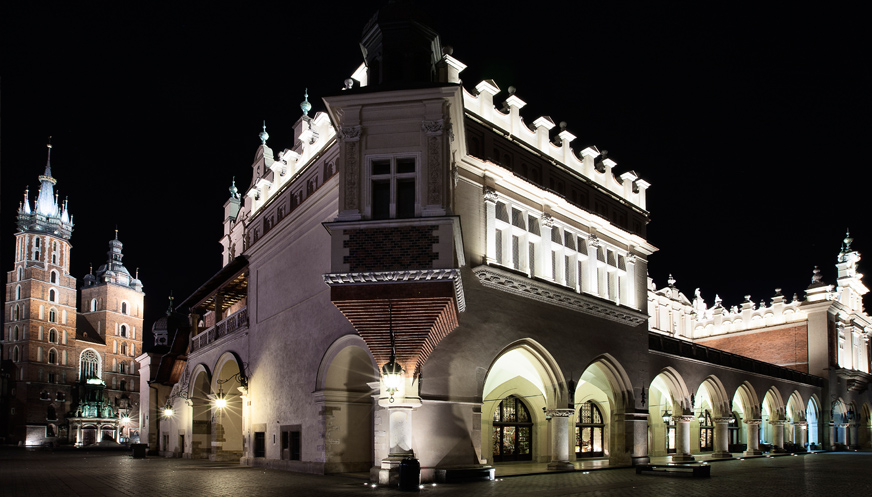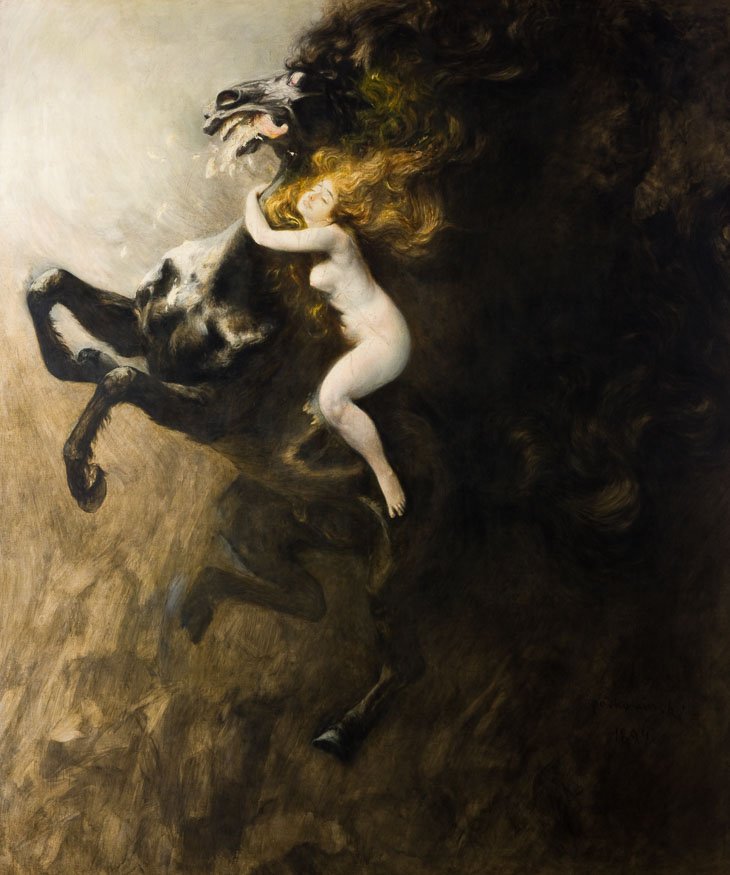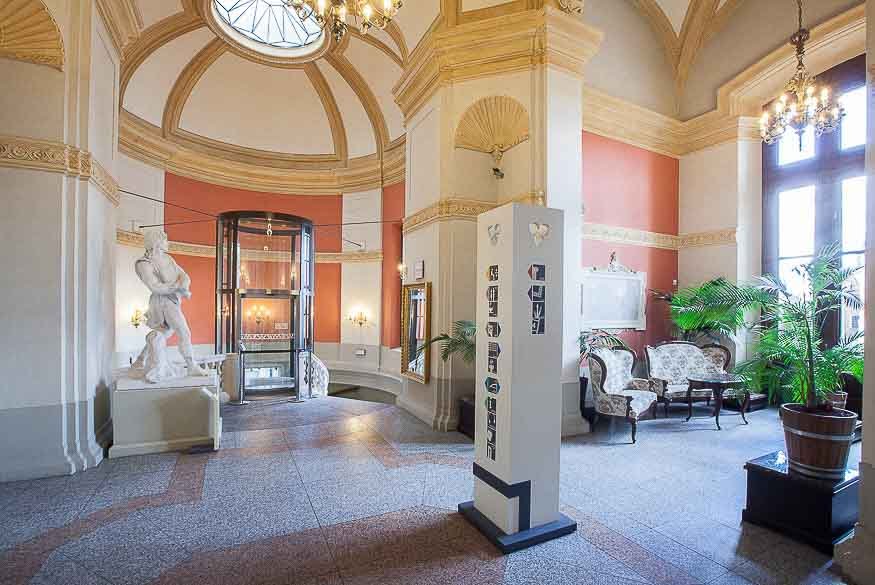The Gallery of 19th Century Polish Art in the Sukiennice will be open until 2:00 p.m. on December 4, 2025.
The Gallery of 19th-Century Polish Art in the Sukiennice will be closed to visitors on 11 December 2025.
We apologize for any inconvenience.
Tuesday is the day of free entry to permanent exhibitions at the NMK.
The museum is closed on Mondays.
Opening hours for organized groups booked through the MNK Information and Reservation Center:
Tuesday: 9:00-18:00
Friday: 9:00-18:00
The Gallery of 19th-Century Polish Art in the Sukiennice will be closed to visitors on 11 December 2025.
We apologize for any inconvenience.
Tuesday is the day of free entry to permanent exhibitions at the NMK.
The museum is closed on Mondays.
Opening hours for organized groups booked through the MNK Information and Reservation Center:
Tuesday: 9:00-18:00
Friday: 9:00-18:00
The Sukiennice (Cloth Hall) is a large market hall erected in the 13th century in the middle of the Market Square, extended in the 14th century in the Gothic style and remodelled in the mid-16th century after Renaissance fashion. Following its restoration in the years 1875-1879, it began to serve a representative function and became a venue for grand balls and patriotic celebrations. Due to their location and character, the halls on the first floor of the Sukiennice building became the first seat of the National Museum in Krakow. Initially, the Museum shared this space with the Society of Friends of Fine Arts.
History
On 7 October 1879, the Krakow City Council founded the first National Museum on the Polish territory. The exhibition inaugurating the activity of the Museum was opened on 11 September 1883, on the eve of the bicentenary of the Battle of Vienna, in two rooms on the first floor of the Sukiennice, facing Bracka street. Since then, the permanent gallery of the National Museum was housed in this location. The first director of the new institution was Władysław Łuszczkiewicz (1883-1900), followed by Feliks Kopera (1900-1949).
In 1901, the National Museum took over the entire floor of the Sukiennice. 1902 and 1903 saw the creation of a modern museum gallery, which remained almost unchanged until 1939. The display presented arts and crafts from the 15th to the 19th century, painting and sculpture of the second half of the 19th century, drawings and watercolours, national memorabilia as well as archaeological and ethnographic exhibitions. During the First World War the Museum activity was interrupted for a few months, and during World War II - for five years, from 1939 to 1945.
In the years 1950-1956, under the directorship of Tadeusz Dobrowolski, the Sukiennice halls offered a new exhibition which presented exclusively Polish painting and sculpture from the Enlightenment to the end of the 19th century. The same chronological order of the displayed works was preserved by Directors Adam Bochnak (1957-1962), Jerzy Banach (1963-1974) and Tadeusz Chruścicki, under whose administration the Sukiennice Gallery was remodelled by Mieczysław Porębski, Andrzej Pawłowski and Jan Kolanowski. This time-honoured chronological order of the exhibition is still visible today.
A fundamental change was brought about by Director Zofia Gołubiew (since 2000). The Gallery underwent conservative renovation, gaining a new layout and decor. All the museum halls existing in the Sukiennice were transformed and modernised and new spaces were acquired - on the ground floor, mezzanine and terraces.
The present layout of the exhibition was designed by Barbara Ciciora and Aleksandra Krypczyk, who took into consideration the interior changes devised by Jacek Cupryś. The aesthetics of the Sukiennice Gallery still refers to the 19th-century manner of displaying art.
The exhibition in the Sukiennice is presented in the following four rooms:
The Gallery of 19th-Century Polish Art is a continuation of the Gallery of the Art of Old Poland from the 12th to the 18th Century, situated in the Bishop Erazm Ciołek Palace. The display exhibited in the Sukiennice is chronologically followed by works presented in the Gallery of 20th-Century Polish Art in the Main Building of the National Museum in Krakow.
On 7 October 1879, the Krakow City Council founded the first National Museum on the Polish territory. The exhibition inaugurating the activity of the Museum was opened on 11 September 1883, on the eve of the bicentenary of the Battle of Vienna, in two rooms on the first floor of the Sukiennice, facing Bracka street. Since then, the permanent gallery of the National Museum was housed in this location. The first director of the new institution was Władysław Łuszczkiewicz (1883-1900), followed by Feliks Kopera (1900-1949).
In 1901, the National Museum took over the entire floor of the Sukiennice. 1902 and 1903 saw the creation of a modern museum gallery, which remained almost unchanged until 1939. The display presented arts and crafts from the 15th to the 19th century, painting and sculpture of the second half of the 19th century, drawings and watercolours, national memorabilia as well as archaeological and ethnographic exhibitions. During the First World War the Museum activity was interrupted for a few months, and during World War II - for five years, from 1939 to 1945.
In the years 1950-1956, under the directorship of Tadeusz Dobrowolski, the Sukiennice halls offered a new exhibition which presented exclusively Polish painting and sculpture from the Enlightenment to the end of the 19th century. The same chronological order of the displayed works was preserved by Directors Adam Bochnak (1957-1962), Jerzy Banach (1963-1974) and Tadeusz Chruścicki, under whose administration the Sukiennice Gallery was remodelled by Mieczysław Porębski, Andrzej Pawłowski and Jan Kolanowski. This time-honoured chronological order of the exhibition is still visible today.
A fundamental change was brought about by Director Zofia Gołubiew (since 2000). The Gallery underwent conservative renovation, gaining a new layout and decor. All the museum halls existing in the Sukiennice were transformed and modernised and new spaces were acquired - on the ground floor, mezzanine and terraces.
The present layout of the exhibition was designed by Barbara Ciciora and Aleksandra Krypczyk, who took into consideration the interior changes devised by Jacek Cupryś. The aesthetics of the Sukiennice Gallery still refers to the 19th-century manner of displaying art.
The exhibition in the Sukiennice is presented in the following four rooms:
- The Bacciarelli Room: the Enlightenment – which displays the art of the second half of the 18th century and the early 19th century
- The Michałowski Room: Romanticism. Towards National Art – which focuses on national themes in art,
- The Siemiradzki Room: Around the Academy – which presents issues relevant to the academic curriculum in the second half of the 19th century,
- The Chełmoński Room: Realism, Polish Impressionism, Beginnings of Symbolism – which displays the works that herald the art of Młoda Polska (Young Poland) movement, exhibited in the main building of the Museum.
The Gallery of 19th-Century Polish Art is a continuation of the Gallery of the Art of Old Poland from the 12th to the 18th Century, situated in the Bishop Erazm Ciołek Palace. The display exhibited in the Sukiennice is chronologically followed by works presented in the Gallery of 20th-Century Polish Art in the Main Building of the National Museum in Krakow.




